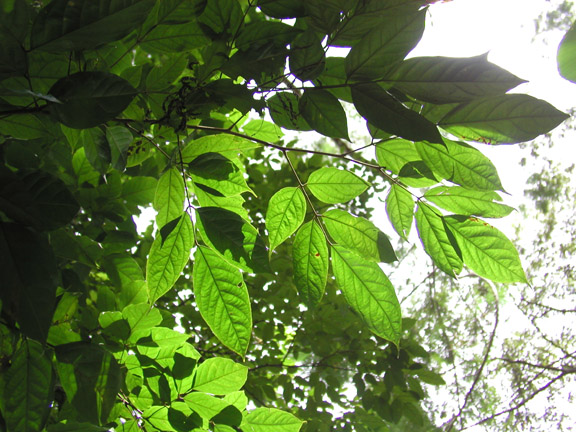Swartzia panamensis Benth.
Fabaceae CARBONCILLO
Occasional understory or subcanopy (15-20 m) evergreen tree found most commonly in drier habitats with well drained soils. Conspicuous and notable for its long, pendulous racemes of bright yellow flowers and fresh-looking, shiny foliage, this tree is attractive and relatively easy to identify in the field.
Description: Carboncillo is a tree of variable form. In harsher habitats (with shallow, rocky soils and high insolation) it tends to form a stunted, irregular, and subdivided trunk with a low, spreading crown. In primary forest conditions with deep soils and high humidity, this species grows taller and exhibits a single, cylindrical and straight bole (55 cm). Such a forest tree sports a crown composed of a thick, umbrella-like layer of horizontal branches and large leaves. Carboncillo lacks buttresses, however the roots exhibit an eye-catching red-orange color at their point of entry into the soil. The remainder of the bark is dull, dark gray, and smooth, with slightly elevated horizontal lenticels.
Leaves are compound (35 by 18 cm), imparipinnate, and alternate. Each consists of five thin, papery leaflets, oppositely arranged along the petiole. Carboncillo blades are smooth, extremely glossy, and bright green – and they retain this fresh-looking appearance throughout their lifetime. Elliptical in shape, the leaflets (16 by 6 cm) end in characteristic, very long (3 cm), curved drip-tips. Some fine, rust-colored pubescence is found on leaf veins and petioles – these latter structures being further marked by creme-colored point lenticels. Leaves turn bright yellow in November, just before being completely shed and re-grown in December and January. New leaves are a phosphorescent yellow-green color and they because of them, Carboncillo crowns stand out from the surrounding forest during the early dry season.
Flowers emerge on long (30 cm), pendulous, racemes that grow from leaf axils. Initially, each raceme supports about twenty, green, globose buds (1 cm) held individually at the ends of long, upward-turning pedestals. The flowers open as the seamless calyxes tear and curl back in five jagged shards, revealing a showy assortment of petals and stamens within. Then the large (4 cm), golden-yellow blossoms dominate the raceme, arranged in a cascading chain of startling color. Each blossom consists of a single large, fan-shaped superior petal and about 100 long, protruding stamens. Curiously, these latter structures are segregated into two distinct clumps. Those stamens comprising the larger, superior cluster are thin and upwardly angled, while the remainder are thicker, arranged in a row, and downwardly oriented. The flowering season is extended, lacking clearly delineated boundaries. It lasts roughly from July through the following March, with an apparent peak around September.
Fruits are very large (25 by 10 cm), elongate, woody pods. Their exteriors are glossy, green, and marked with elevated, brown point-lenticels. Pod interiors are smooth, light-colored, and contain three, large (8 cm), brown, stone-shaped seeds. The pods may persist in the tree, dangling from the ends of long supports far below the main canopy, for as long as 8 months before maturing and splitting open. Seeds then fall directly to the forest floor below. Harvests are spread out over many months, with no notable peak and very scant production. They last from July through January. If conditions are moist, seeds germinate within a month of landing in the soil.
Similar Species: Thanks to Carboncillo’s unusual leaf shape and texture, this species is difficult to confuse with other constituents of Manuel Antonio’s arboreal flora. Only one other treelet – Coralillo (Picramnia latifolia)- has similar, compound foliage with glossy leaflets. However, this is a plant of much smaller size (8 m at most) and its leaflets are alternately arranged along the petiole.
Natural History: Carboncillo’s flowers are heavily visited by bees, searching for and collecting nectar and pollen. Fruits do not appear to have an effective seed-dispersal mechanism, since most pods open in the tree and allow the seeds to fall to the forest floor directly beneath them. However, seeds are rarely found on the ground and this may indicate that Agoutis or Squirrels are carrying them away – to be consumed or perhaps stored (and occasionally forgotten?) in some distant den or cache. They are also large, heavy, and round enough to roll a few meters across the forest floor if dropped from canopy height over a moderate slope. Croat (1978) allows the possibility of water dispersal for this species.
Uses: Holdridge & Poveda (1975) note that this tree has potential use as an ornamental – thanks to its nearly continuous production of golden blossoms. Allen (1956) reports that the wood is hard, heavy, dark brown, and durable and is used in heavy construction in Honduras. Being a legume, it also has obvious, soil enriching potential.
Distribution: This tree is most common along Costa Rica’s humid, southwestern slope. Carboncillo ranges from Honduras to Panama.




